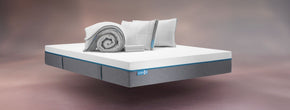How often should you change your mattress?

A comfortable, supportive mattress is essential for a restful night’s sleep. However, once you’ve chosen the right mattress, how long will it be comfortable and supportive ? And is there a timeline on how often you should change your mattress? Looking after your mattress with a mattress protector, regular cleaning, and practising general aftercare will help it last for a long, long time. However, it’s useful practice to get in the habit of recognising when a mattress is ready to change out.
Signs your mattress needs replacing
There are several signs to look out for that point to your mattress needing to be replaced. These include:
- You wake up with aches and stiffness, especially in your joints, neck or back.
- You are having difficulty sleeping well because you can’t get comfortable.
- There are signs of heavy wear and tear, notably yellowing, stains, and rips.
- The edges of the mattress are dipping over the edge of your bed frame.
- Lumps, sagging and dips have formed.
- You’re overheating at night.
- The mattress makes a lot of noise when it is moved, sat or laid on.
- Motion transfer in the night becomes more pronounced.
- Your allergies have become worse, or are more frequently aggravated
- It has an unpleasant odour.
- You sleep better on other, newer mattresses at a friend’s or in a hotel.
The above are the results of damaged, old, and/or unhygienic mattresses. Any one of these can impact the quality of your sleep. Out of these, reduced mattress support can significantly affect your physical comfort. Mattress sagging can result in pain across your body, notably your back and joints. This is due to key parts of your body, like your spine, not being properly aligned as your sleep.
If you don’t keep your mattress regularly clean, it can build up with sweat and skin cells. This is the case even if you clean your bed sheets and linen regularly. It also highlights why using a mattress protector is important! Over time, this build up results in bacteria and mould growing - the warmth and humidity are prime conditions for these to develop. The dust can also attract dust mites too, which can lead to sneezing, itchy eyes, a runny nose, and aggravated asthma. All of these can affect the condition of the mattress’s materials, as well as its structural integrity. It’s just not a pleasant experience to sleep on.
How old is your mattress?
The age and overall quality of your mattress will impact how well it performs over time. A higher quality mattress is far more likely to have a longer lifespan, so is well worth the investment. Materials used are durable and designs are developed to withstand heavy use. At Simba we’re confident in the quality of our mattresses. So much so, we offer a ten year guarantee for every one we sell.
It’s a good idea to keep an eye on your mattress over the years, so you can gauge when to change it. If your mattress is over eight years old and giving you problems, now might be the time to look for a new one.
How long should a mattress last?
There’s no set time limit on how long a mattress lasts - it all comes down to the materials used, quality of construction, its age, and how the mattress is cared for. A mattress can last a lot longer withregular cleaning, rotation or flipping, and a quality mattress protector. We also recommend keeping pets off your bed, as this can result in stains and soiling. Mattresses for young children may need additional care due to accidents that can happen at night.
Mattress Lifespan
As we’ve mentioned, the lifespan of different mattresses ranges significantly from model to model. It can be anywhere from six to fifteen years, with eight-ten being roughly the average. However, there are instances where a high-quality mattress can last even longer.
When to replace your mattress
It’s time to replace your mattress when one or more of the replacement signs listed above become a regular occurrence. In some cases, one off incidents like overheating or aggravated allergies may be caused by something else. However if these repeatedly crop up, we recommend investigating whether your mattress is contributing to your symptoms. If so, it’s time to look for a new mattress.
"It strikes a perfect balance between comfort and support"- Philip M, Hybrid® Luxe Mattress
"The Ultra is the best mattress I have ever owned!"-Nicko B, Hybrid® Ultra Mattress















